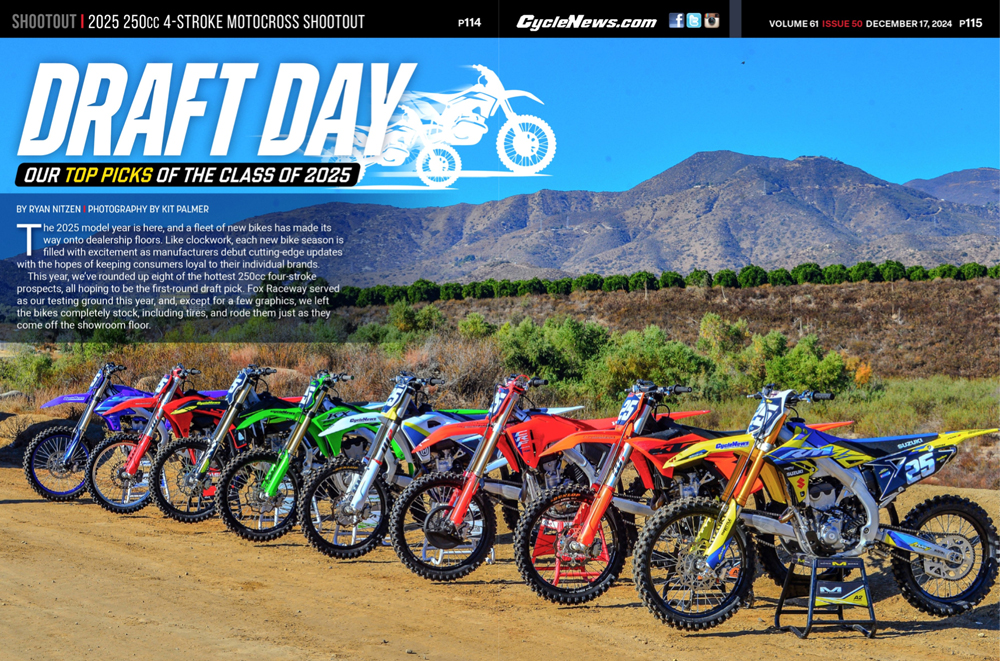Ryan Nitzen | December 20, 2024
The 2025 model year is here, and a fleet of new bikes has made its way onto dealership floors. Like clockwork, each new bike season is filled with excitement as manufacturers debut cutting-edge updates with the hopes of keeping consumers loyal to their individual brands.
This year, we’ve rounded up eight of the hottest 250cc four-stroke prospects, all hoping to be the first-round draft pick.
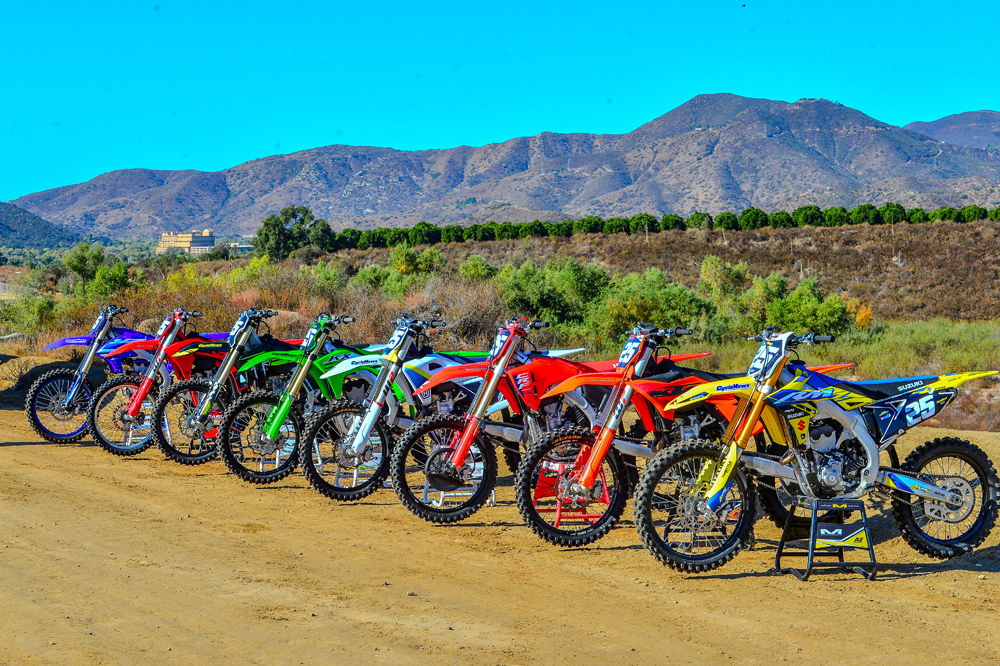
Fox Raceway served as our testing ground this year, and, except for a few graphics, we left the bikes completely stock, including tires, and rode them just as they come off the showroom floor.
The Prospects | 2025 250cc 4-Stroke Motocross Shootout
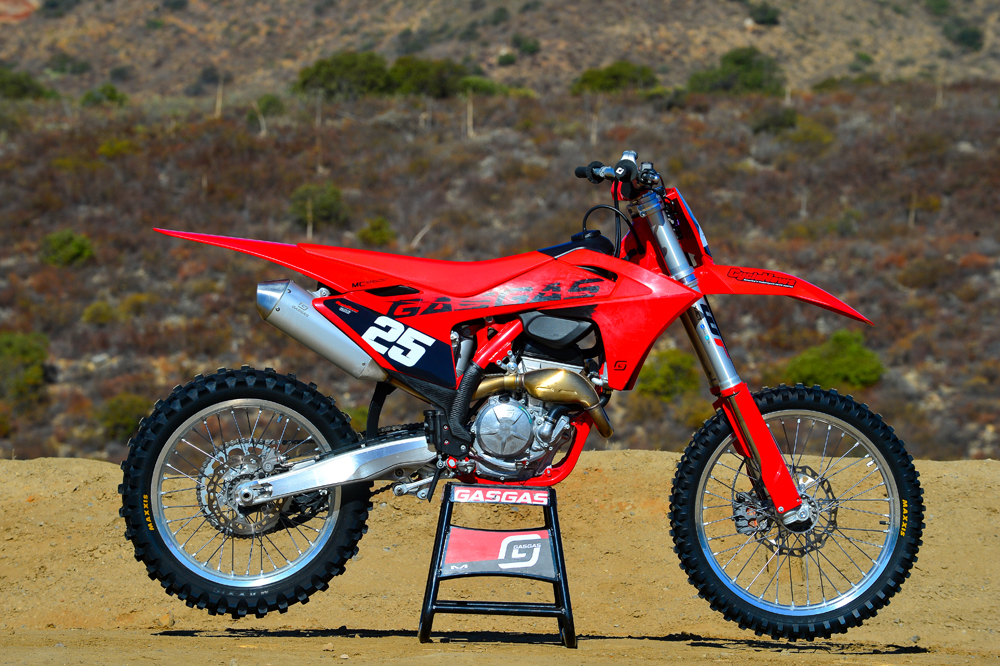
2025 GasGas MC 250F
$9599
Wet weight: 238 lbs.
GasGas again makes up one-third of the Austrian machines in this year’s shootout. For 2025, the Gasser features a newly updated frame, just like the 450, along with new suspension settings to match. Braktec brakes and clutch come standard, as do Maxxis Maxxcross MX-ST tires. The GasGas receives the same base package as the KTM and Husqvarna—frame, engine and suspension components—but it is not equipped with the same brakes, wheels, clamps or electronics. Instead, the GasGas lacks a map switch, traction control and a quickshifter as standard. Priced at $9599, it is the most affordable of the European models ($800 less than the KTM), although it is also the heaviest of the Austrians.
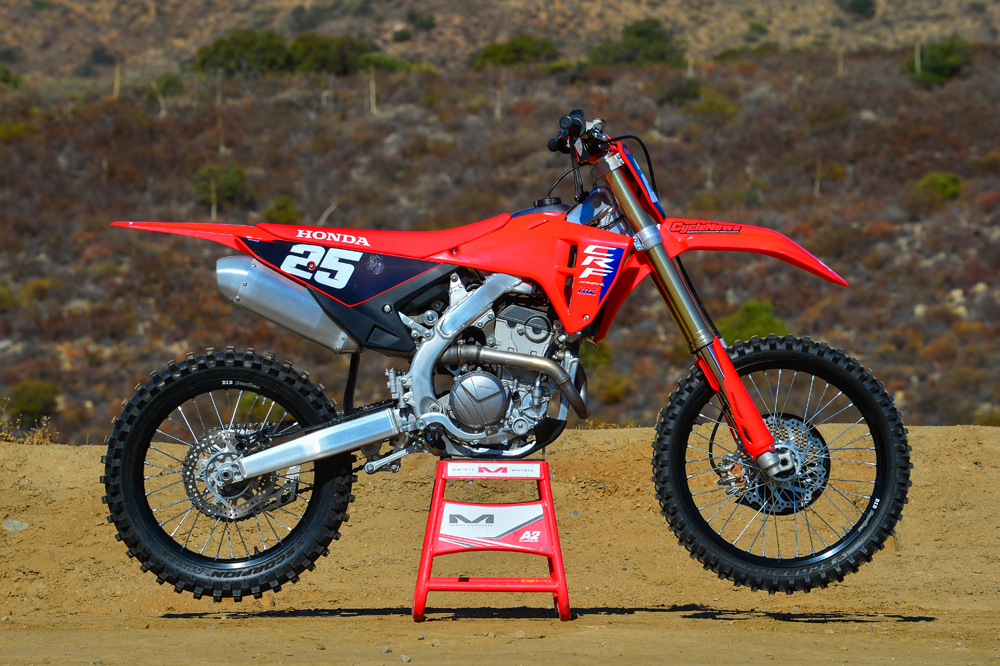
2025 Honda CRF250R
$8299
Wet weight: 232 lbs.
The Honda CRF250R is all new for the 2025 model year. With a major overhaul, the Honda gets a stiffer frame, a new shock mount, and a redesigned airbox, all wrapped in fresh bodywork. The motor design resembles last year’s bike, but the revised airbox layout emphasizes low-end usability. A map switch offers three riding modes with traction control. Honda also focused on pricing. At $8299, it’s only $100 more than the Suzuki and $600 less than the Yamaha. It’s also the second lightest in the group, just two pounds heavier than the Triumph.

2025 Husqvarna FC 250
$10,499
Wet weight: 235 lbs.
The Husqvarna FC 250 is branded as the most premium bike in its class, and with it comes the highest price tag. At $10,499, it’s the most expensive bike, beating out the KTM by just $100. The FC has a new Austrian frame and sits lower to the ground with shorter WP suspension. Ground clearance is a quarter inch lower and seat height is an inch lower compared to the KTM. Brembo brakes, Brembo clutch, D.I.D Dirt Star wheels, Dunlop tires and a full suite of electronics are among the other top-tier components on the Husky.
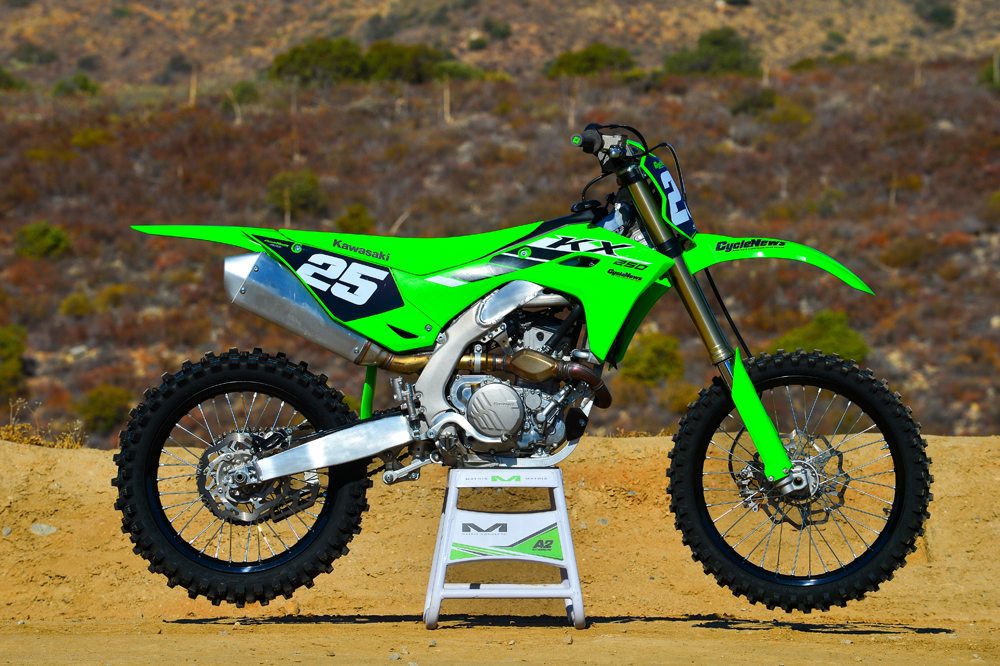
2025 Kawasaki KX250
$8999
Wet weight: 240 lbs.
Kawasaki’s KX250 enters the lineup as one of the all-new models for 2025. It now matches its KX450 counterpart with a new frame, engine design and center-port exhaust. The bodywork is redesigned for 2025 with fewer bolts, fewer seams and tool-less air-filter access. Mapping is controlled by the handlebar-mounted switch, which offers two different modes and traction control that can be further tuned via the updated Rideology smartphone app. ODI Lock-On grips and Showa suspension are new features. The Kawi gained three pounds over the previous model and, at 240 pounds, is the heaviest 250 in this test.
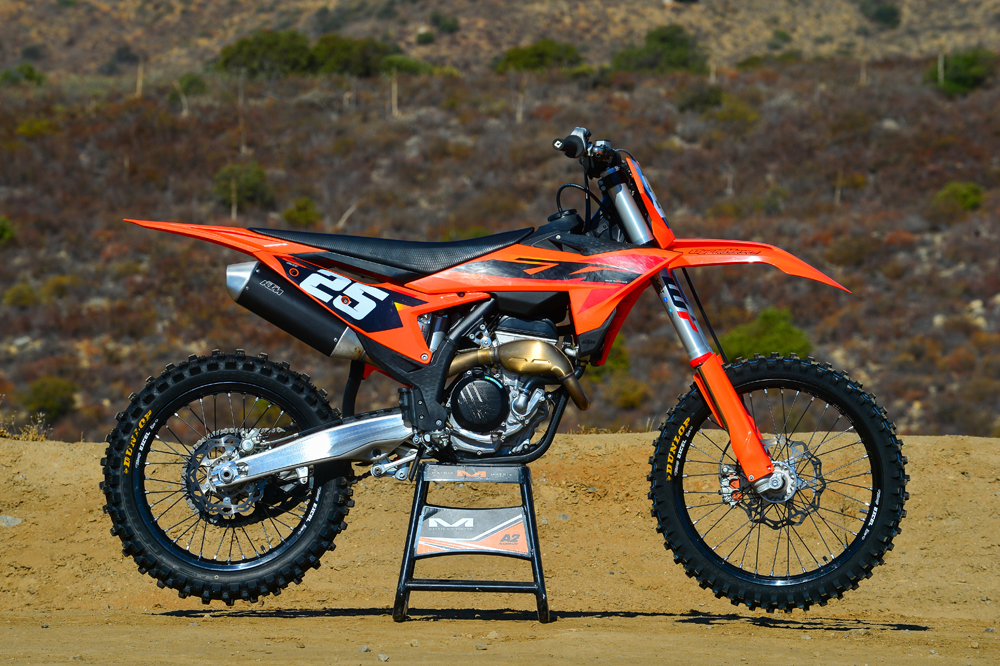
2025 KTM 250 SX-F
$10,399
Wet weight: 236 lbs.
The KTM 250 SX-F sits between the Husqvarna and the GasGas in nearly every aspect. Considered the “race-ready” machine in the Austrian fleet, it features the same “windowed” frame that was first introduced on last year’s Factory Editions. You will still find the familiar WP Xact suspension, Brembo brakes and clutch, and the full electronics suite with two maps, traction control and quickshifter capabilities. It’s no longer the lightest bike of the bunch, and the $10,399 price tag makes it the second most expensive, just $100 less than the Husqvarna.
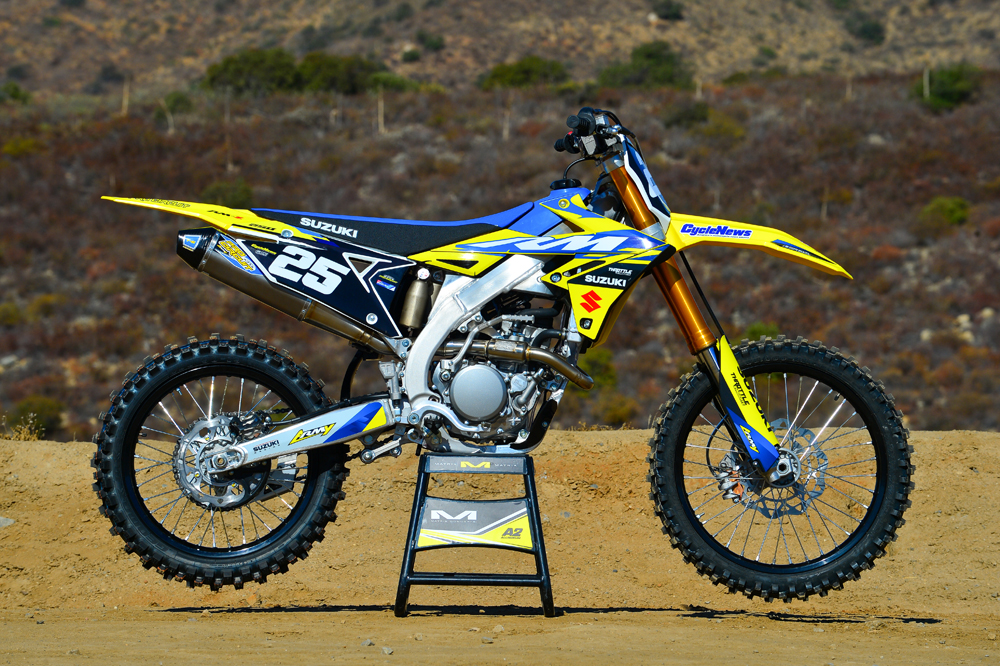
2025 Suzuki RM-Z250
$8199
Wet weight: 237 lbs.
The Suzuki RM-Z250 is again unchanged. The RM Army Edition, however, is available until December 31, 2024, and includes one of five different “RM Era” graphics kits plus a Pro Circuit T-6 full exhaust system at no extra cost. It is the least expensive bike in the group, barely beating the Honda by $100, and is still the only bike in the class with a kickstarter. The Suzuki engine is proven to be reliable with capable suspension and worthy brakes. At 237 pounds, it comes in just under the GasGas and the Kawasaki in weight by one and three pounds, respectively.
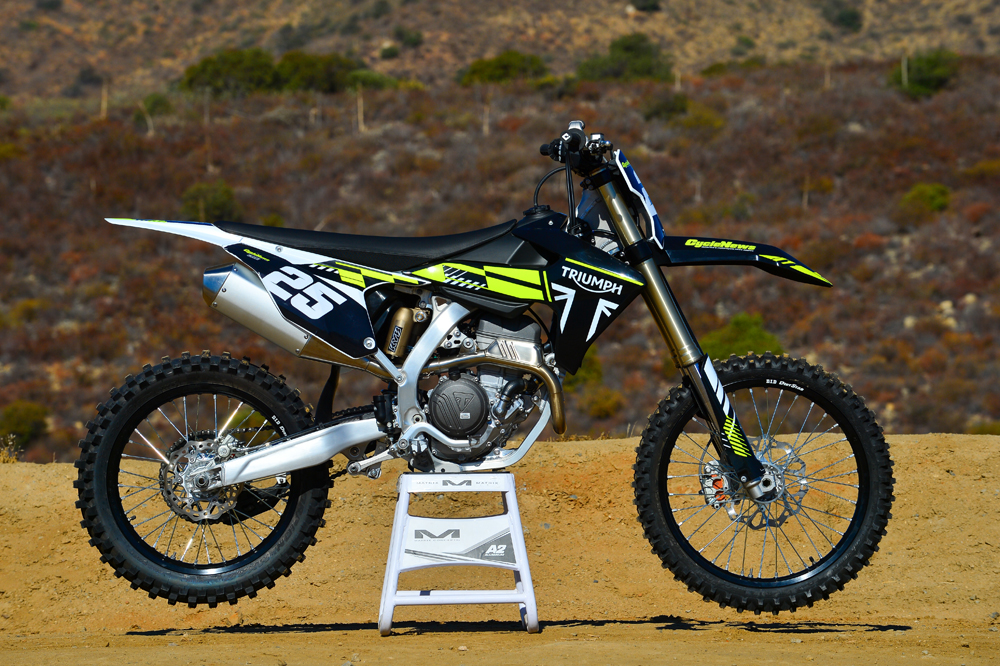
2025 Triumph TF 250-X
$9495
Wet weight: 230 lbs.
The most anticipated bike of the new year is the Triumph TF 250-X. In its first year of motocross competition, Triumph went for the jugular by entering the lightest bike in the group—two pounds lighter than the Honda and 10 pounds lighter than the Kawasaki. The Triumph is chock-full of race-ready components, including KYB suspension, Brembo brakes and clutch, ProTaper ACF handlebar, ODI Lock-On grips and Pirelli tires. Plus, a full suite of electronics—including dual maps, traction control, a quickshifter and launch control—come standard.
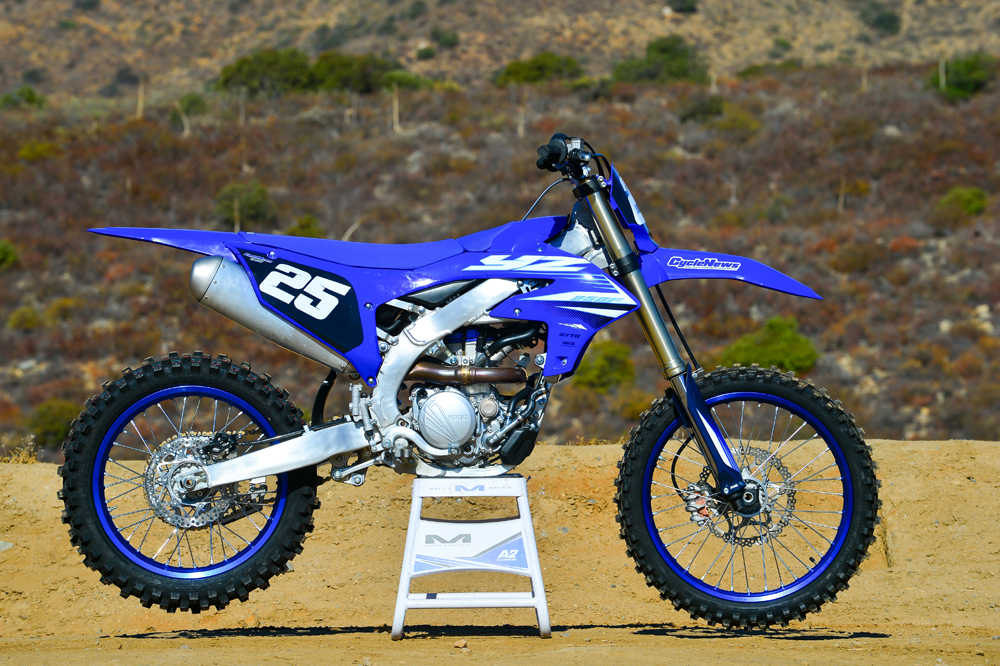
2025 Yamaha YZ250F
$8899
Wet Weight: 236 lbs.
While it looks and feels like the 2024 model, key changes have been implemented in the 2025 YZ250F. The suspension department features a new linkage, along with revised shock and fork settings, a lighter spring rate for the rear shock, and delta-shaped piston shims in the fork. These enhancements aim to improve stability while providing a more planted front-end feel. The cockpit also receives factory-inspired touches, with the control buttons recessed to minimize the risk of accidentally bumping them while riding. The throttle tube is positioned further from the grip to prevent YZ-induced blisters known as “Yamathumb.” Furthermore, the footpeg brackets are now lighter in weight and modified to provide your ankles with better grip to the bike.
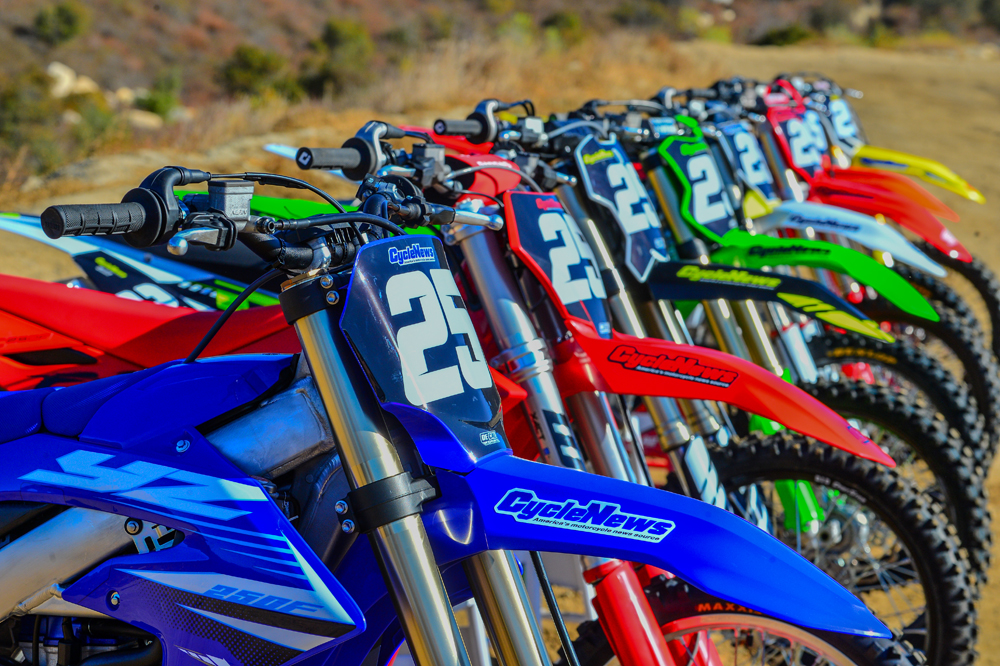
VIDEO | 2025 250cc Motocross Shootout
Which Bike Is Best??
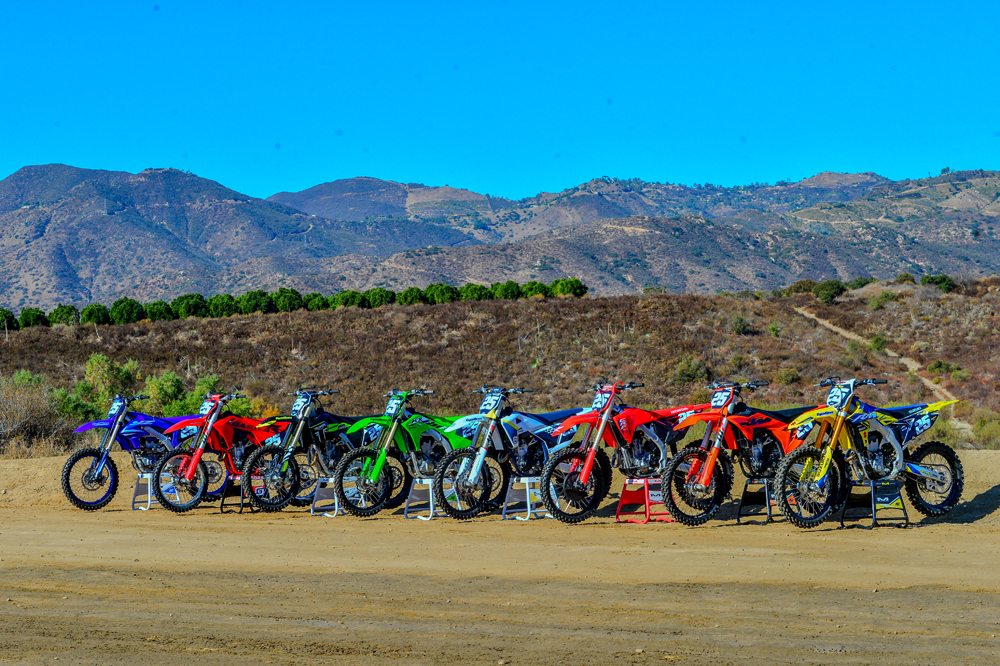
2025 250cc 4-Stroke Motocross Shootout Results
8th Place
Suzuki RM-Z 250
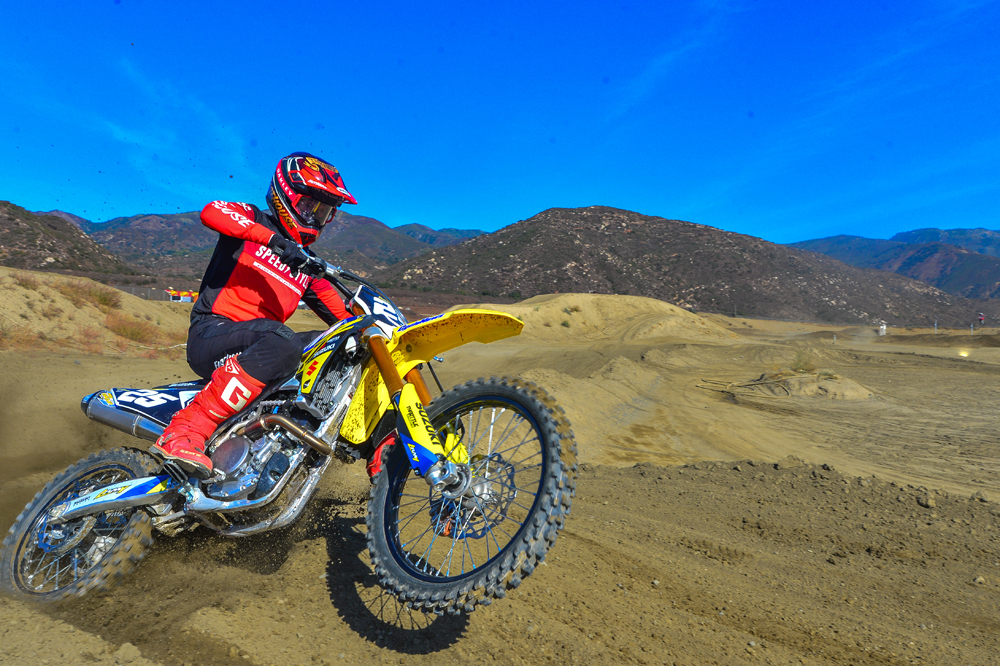
With virtually no R&D improvements since its last redesign in 2019, the RM-Z falls behind on the track and in the overall results. The RM Army package is certainly a nice touch, but an aftermarket exhaust and graphics just aren’t enough to bump it past any of the other stock competitors.
The RM-Z’s engine is still well-liked and suitable for novice-level riders or those looking to step up from the Supermini class. It’s smooth and controlled but still delivers a decent punch in the midrange. There’s a small window of power where the bike pulls, and the aggressive map is a must if you want to compete with others. The full Pro Circuit system is a nice touch, but the bike still lacks comparable low-end torque and doesn’t have the overrev like the other bikes have. Getting maximum power out of the RM-Z for the intermediates and experts will require some internal work.
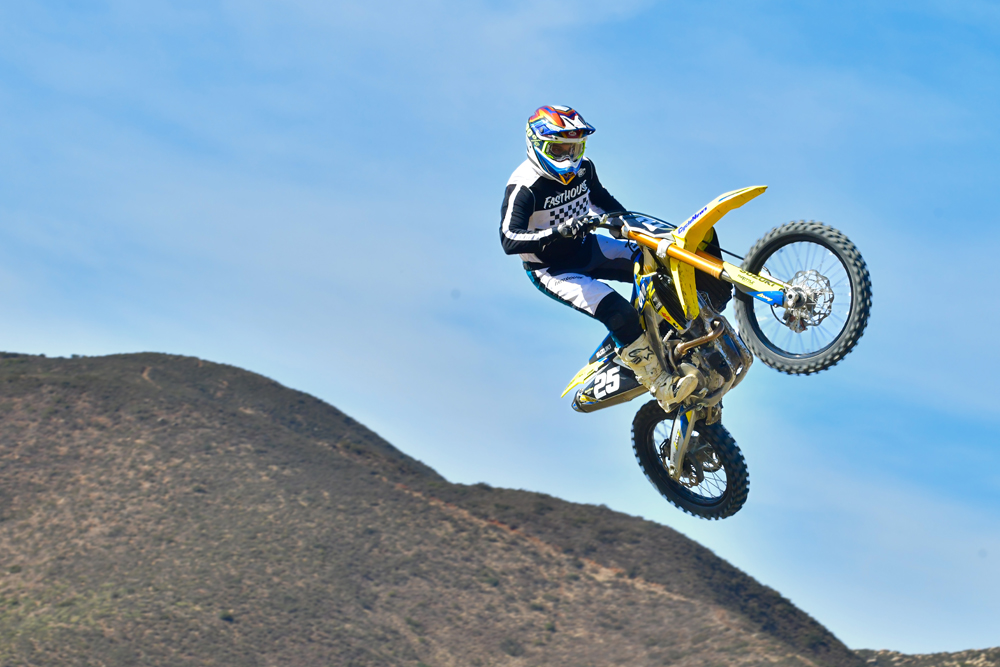
The RM-Z’s suspension is the Suzuki’s weak point. It’s overly stiff. The forks feel like a Supercross setting, and the shock setup just doesn’t match. It’s been like this for the past six years. The suspension requires riders to push the bike hard for the forks to work properly, but the motor has a hard time getting up to that point. The forks are over-sprung, and the motor is, in comparison to the other bikes, underpowered. And still having to kickstart it without any weight-saving benefits doesn’t help it any.
However, on a smoothly prepped track, the Suzuki works well. Plus, you can find great deals on the new RM Army RM-Zs that come with the full Pro Circuit system, a nearly $1200 savings. The Suzuki has its pluses, for sure, but in a class full of technological advancements and big horsepower, we’re forced to place the Suzuki at the back of the pack.
7th Place
Kawasaki KX250
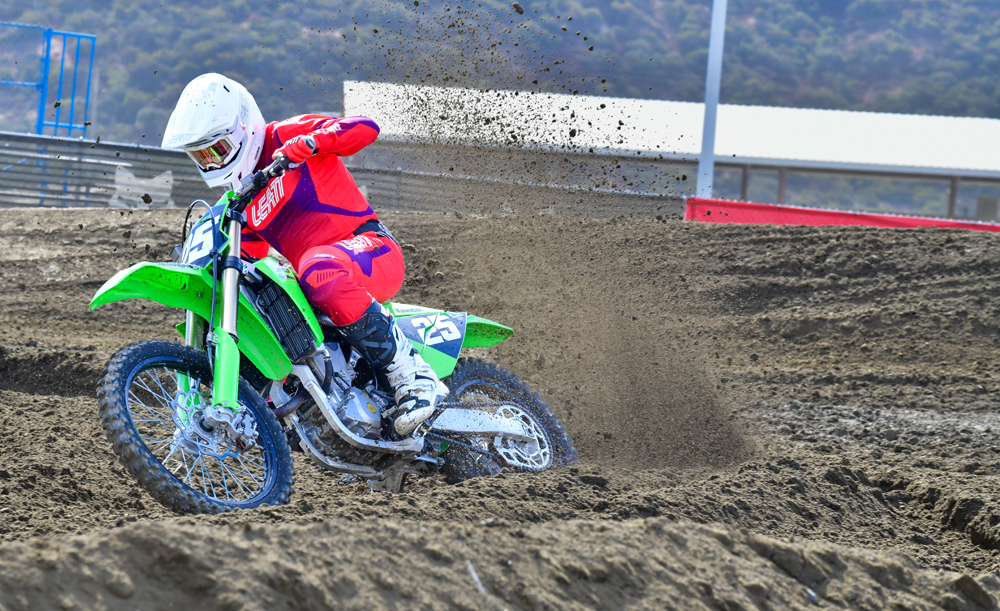
The seventh-, sixth- and fifth-place bikes all found themselves in a close grouping. The Kawasaki, however, gets shuffled back to seventh.
The KX250 is an all-new bike for 2025, and while it’s ranked lower than expected in our comparison, there is still a lot we like about this bike. The new chassis and new Showa suspension work in harmony. The bike feels much more comfortable and easier to ride over a longer period than the 2024 KX. The frame and chassis make you and the bike feel at one with the ground, and the bike is very predictable. It goes where it’s pointed. It requires little to no effort to make it lean in for the corners, and it stays planted in the ruts. The fork and shock are also much more compliant and do a good job of soaking up the bumps rather than simply bouncing off them.
Another plus is the electronics. Finally, the Kawasaki has a handlebar-mounted switch with two programmable maps, and they are simple to use. Kawasaki’s Rideology phone app also allows you to tune the bike or change maps. The stock map is good, but more experienced riders will quickly break out their phones and come up with a more aggressive setting.
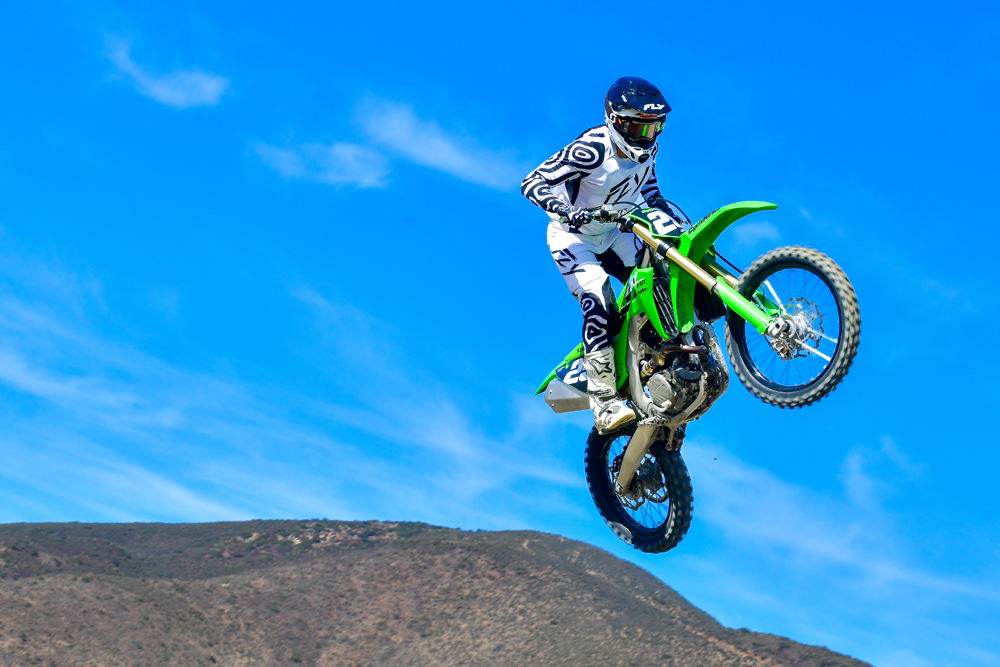
At this point, you might be wondering why we rated the KX seventh. Mainly because of its slow-revving motor, which makes the bike feel, dare we say, slow in comparison. Intermediate- and expert-level riders have to work a little harder just to keep up with their competitors. Carrying momentum and keeping rpm in the upper range is essential for fast lap times on the Kawasaki.
Another minus is the weight. At 240 pounds wet, the Kawasaki is a full 10 pounds heavier than the English newcomer, Triumph. Pair this weight with the ultra-linear powerband, and the bike feels sluggish on track. In this class, power-to-weight is everything.
Despite its lower-than-expected placing, we still like the Kawasaki; it’s comfortable and easy to ride. The lock-on grips, switchable maps, tool-less airbox cover and excellent suspension are things we’ve been wanting for years. These improvements do make for a better riding experience, but the engine character and increased weight are hard to overlook.
6th Place
GasGas MC 250F
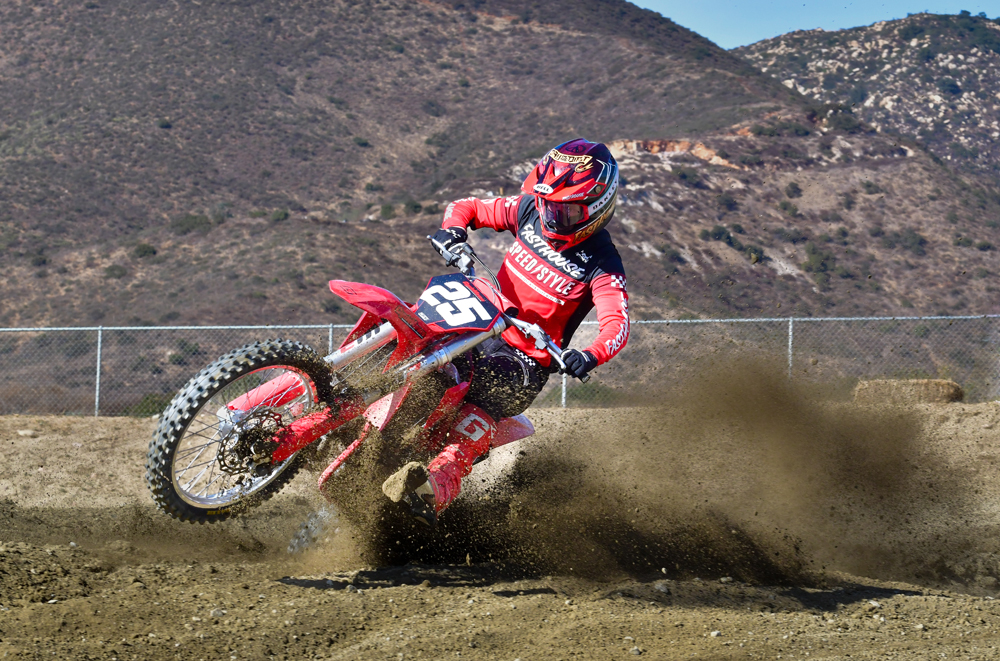
As far as numbers go, the GasGas is the heaviest of the Austrian bunch and, in turn, comes standard with the least amount of “choice” parts from the OEM. That means riders miss out on the map switch, traction control, Brembo brakes, Brembo clutch, Dunlop tires and black rims. Does that warrant the extra $800? That’s a conversation for you and your wallet.
While it is becoming harder and harder to differentiate the offerings from the KTM Group, the GasGas was voted as having the most fun engine of the three Austrians. Despite having the same platform as the KTM and Husqvarna, something inside the red ride allows it to rev a tick faster. It comes alive faster with a snappier feel on the down low and continues a strong, connected pull through the midrange. As usual, these bikes keep going well into the red zone, and the GasGas doesn’t shy away from the overrev. This engine somehow felt the spunkiest of the Euro group, even with the lack of mapping adjustment, and earned the most praise throughout our test.
Suspension docked the GasGas in its overall ranking. The settings are designed to be a bit more relaxed and comfortable instead of the stiffer and racier specs found in the KTM. In turn, this makes the GasGas feel a bit softer and more “wallowy” the faster you ride it. Bigger hits are more noticeable as the suspension travels deeper into the stroke, front and rear. This flex makes the bike feel less predictable at times, especially when guiding it into a rut at speed with braking bumps at the entrance. Slower riders might not push the bike to this limit, but the faster ones who enjoy the high-revving powerplant will feel the effects of the less-forgiving suspension settings.
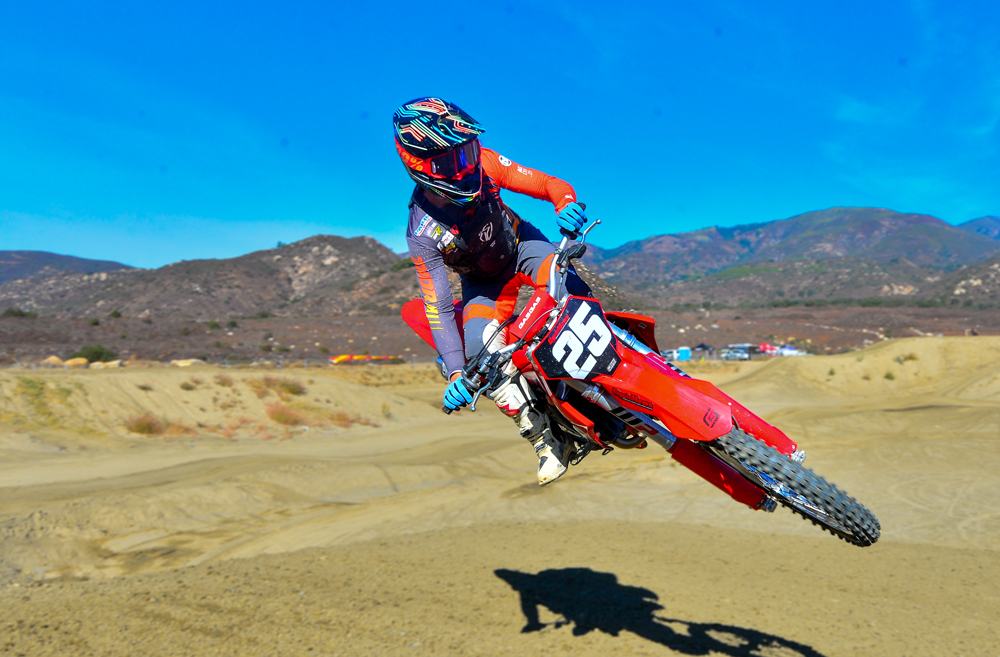
The GasGas gets the same new frame as its cousins. Its steel construction is useful in choppy bumps and makes it easy to corner in hard-packed conditions. At 238 pounds, the GasGas is the second heaviest in the group; the Kawasaki is two pounds heavier. The free-revving character and nimble chassis help mitigate the added weight.
The silver wheels, unbranded handlebar and lack of easy mapping adjustability are further evidence as to why the GasGas is priced lower than the other European bikes. These aren’t real drawbacks regarding performance, but the look and feel aren’t as premium as the Husqvarna or the KTM. The Braktec brakes have improved over the years but still lose out in a head-to-head against the class-leading Brembos. While it’s the least expensive of the Austrian bikes, the GasGas is still more pricey than any of the Japanese models.
Even though the engine is the most fun of the Austrian bikes, it doesn’t make sense to rank the GasGas higher than the KTM or the Husqvarna. The GasGas is a blast to ride, but the lack of mapping adjustment, softer suspension settings, and Braktec brakes dropped it down in the overall ranks.
5th Place
Husqvarna FC 250
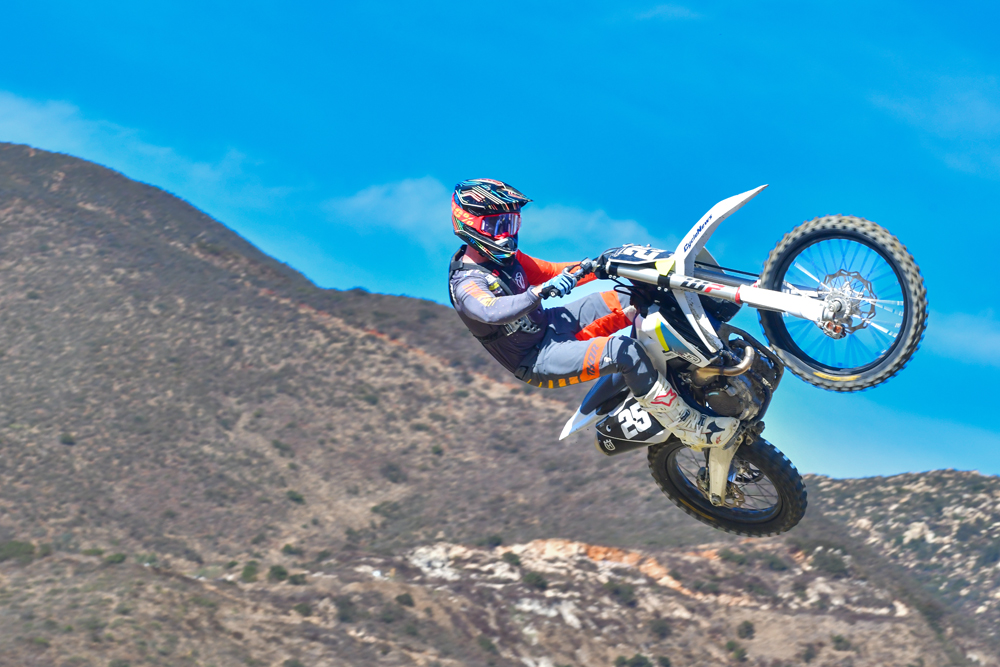
The FC 250 rounds out the top five this year. With three very similar rides coming out of Austria, riders must nitpick the pros and cons of each bike. Again, the Husqvarna surpasses the lower-priced GasGas but still misses out on topping its orange counterpart.
The motor is the Husky’s strongest asset. Crisp mapping and strong, usable power create a fun ride that’s consistent across all areas of the rpm curve. The throttle and rear wheel feel directly connected: the more you give, the more it takes. This engine, while technically the same as the GasGas, offers a smoother hit from the bottom to midrange. It still revs well past the 10K mark, but the initial roll-on is more manageable than the happy-go-lucky GasGas. The closed-off airbox restricts airflow slightly more than its red or orange relatives. This makes the overall engine character feel more controlled and easier to ride during a long moto.
If you want all the bells and whistles, you’ll want the Husqvarna. The white stallion comes chock-full of every electronic add-on you could want. Two maps, traction control and a quickshifter—this bike has it all. We prefer the more aggressive map two for its harder hit and ramped-up torque. It gives the bike some extra oomph from the bottom end while still maintaining that strong mid- to top-end range that we enjoy on European bikes. A handful of riders also used the traction-control option for added confidence once the track dried out. This helps with rear wheel slip and keeps the bike in a straight line when under power in sketchy conditions.
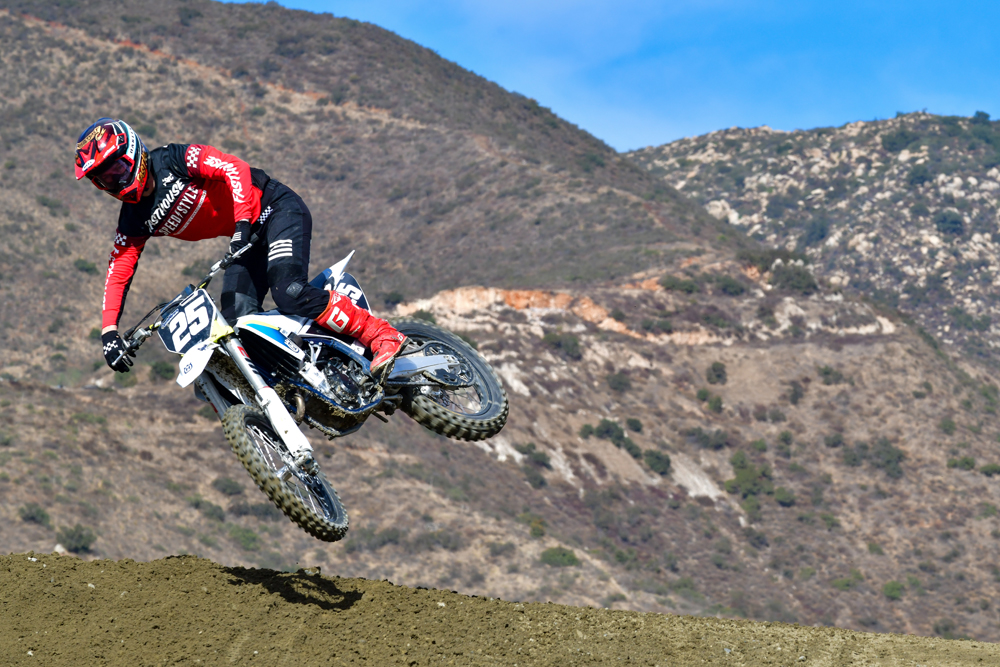
The Husky’s new frame got positive feedback. This bike feels more compliant than the ’23 and ’24 models, which debuted a stiffer steel frame. Now, the new “windowed” frame feels more like the ’21 and ’22 bikes and allows the chassis to flex more while absorbing on-track chatter. The steel frame is a huge asset for tracks with flat corners. It turns on a dime and doesn’t require a rut or berm to bank off. The ability to move the bike on track, whether changing lines or squaring off a turn, further adds to the Husky’s ease of use when riding.
The FC 250’s lowered suspension got mixed reviews. The lower center of gravity helps keep the bike glued to the ground, especially in flat turns, but having nearly a quarter inch less suspension means bumps feel harsher than they do on comparable rides. The fork rides deeper in the stroke and packs easier than the air fork on the KTM. Depending on rider height, this can play a more or less significant factor. Taller riders docked the Husky for feeling too low to the ground, while it wasn’t as much of a deal-breaker for shorter testers. The ProTaper bar also features less rise, contributing to an overall lower feeling.
The Husqvarna is the most expensive bike in the class, but its premium features, like the Brembo brakes and clutch, almost justify its price. Unfortunately for Husqvarna, these top-of-the-line components are the same ones used on the KTM and the Triumph, which are, respectively, $100 and $1000 less. If the Husky is to beat the KTM, the differences need to be more than just white plastic and a lowered suspension.
4th Place
Honda CRF250R
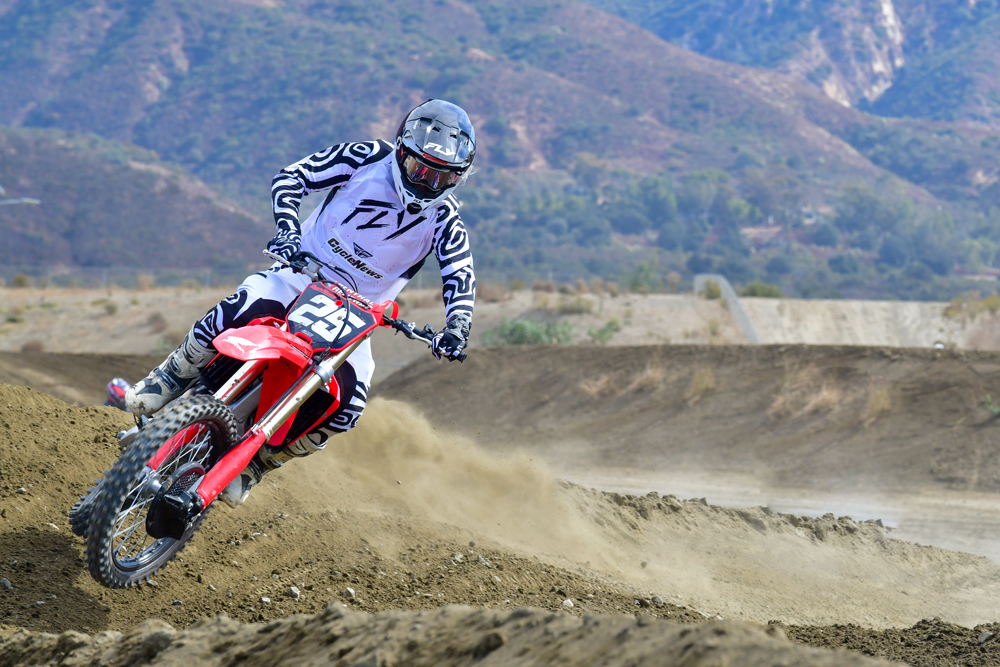
The top four bikes in this test could be interchanged with one more or one less rider’s opinion. The Honda CRF250R is a much better bike for 2025, but it narrowly misses the podium in fourth place. Still, the fact that it could now be vying for a podium spot is a huge improvement over its last-place result just a year prior.
The CRF moves up in the ranks largely thanks to its new, stiffer frame and shock mount. The previous-gen CRF felt too stiff, but Honda says that was because the frame was flexing too much. Now, the bike comes standard with reinforcements to the head tube and rear shock mount. This makes a big difference in damping vibrations and keeping the bike planted on the ground in a straight line. The frame keeps the bike aligned on the track and allows the suspension to perform its job effectively. There’s better feedback, and the frame and suspension no longer seem to fight each other for balance. Riders can now trust that the bike will stay underneath them.
The engine is another one of the CRF’s strong suits. The previous Honda 250 had a high-strung personality and only delivered power in the far upper ranges of the rpm curve. While the new engine is predominantly the same, a new airbox, exhaust and gear ratios provide noticeably more torque from the bottom while still retaining the benefits of that high-revving character. The added grunt now allows you to navigate the inside ruts with less effort, and the bike no longer begs to be shifted as often as before. Map three’s aggressive option was our crew’s go-to for its powerful blend of enhanced low-end pull and crucial mid- to top-end performance. It seems the CRF now has what it takes to compete with the best of them. Overall, the engine felt throatier and simply stronger than before without sacrificing the top-end overrev that has become synonymous with the latest generation of 250 four-strokes.
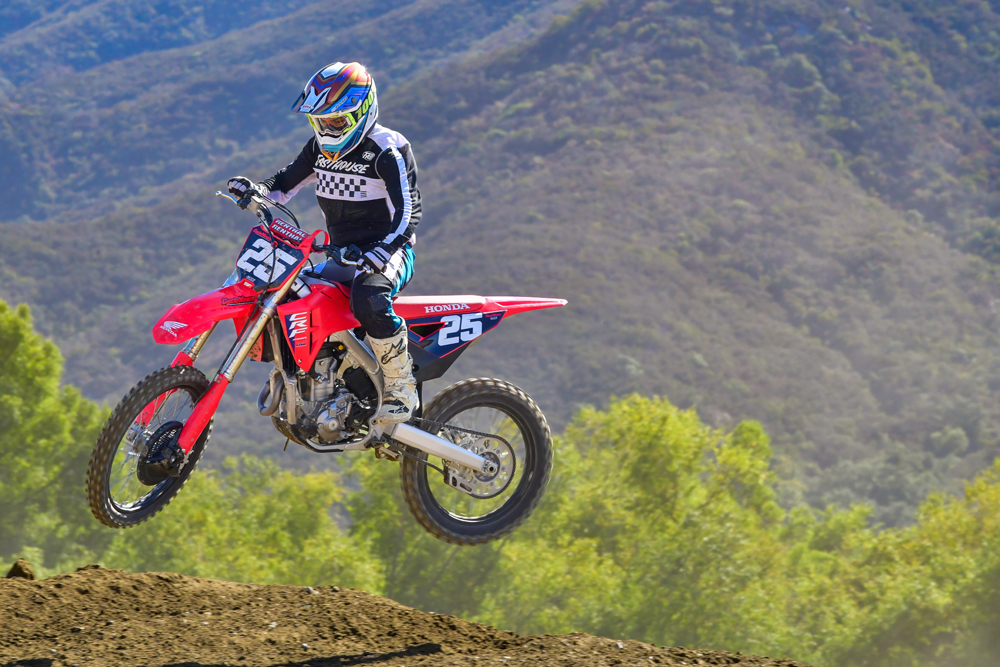
The 49mm Showa fork has been reworked to match the new frame. The fork now operates smoothly and easily absorbs repetitive small bumps while also handling big hits with ease. It’s nowhere near as stiff as it was just a year ago, and vibrations from the wheel and fork no longer hinder the rider’s experience. The shock also feels planted under power and is much less pitchy than before. It feels more predictable and doesn’t kick around like a wild animal. The overall feel of the fork and shock is much plusher and not nearly as notchy as before.
At 232 pounds, it is now the second lightest bike in the group, missing out to the Triumph by two pounds. The lightweight nature is something you can feel as the bike moves around on the track and in the air with ease.
Despite all of its strong points, the Honda wasn’t our first draft pick. The engine just isn’t as strong as the KTM or the Yamaha, and the suspension is still a few clicks off from the KYBs on the Triumph or Yamaha. Still, big ups are deserved at the Honda camp for their work, and you won’t be disappointed if you choose the red route.
3rd Place
Triumph TF 250-X
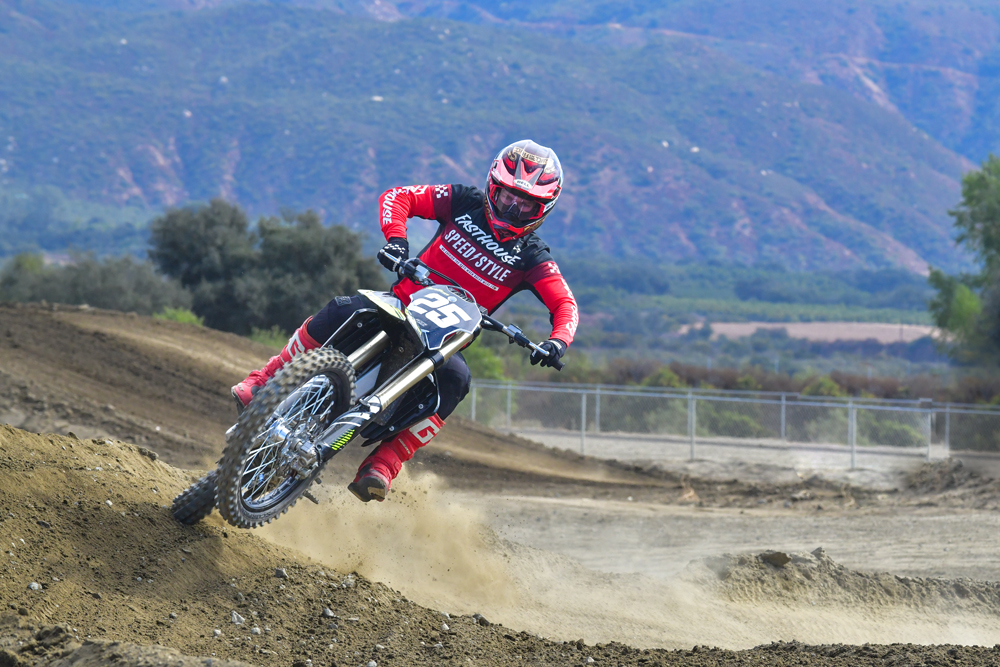
The fight for the first-round draft pick turned out to be closer than we thought. The all-new Triumph TF 250-X was a hit among our riders and landed third in our overall 250 shootout.
The new TF is the lightest bike in the class, beating the Kawasaki by a full 10 pounds. All our riders noticed this weight difference in their early laps. It makes the engine feel less stressed and more free-revving, and also easier to maneuver on the track.
At first glance, the Triumph’s engine looks eerily like the Austrian’s. It rides like one, too. The throttle feel is ultra-connected, and the initial snap of the engine is apparent. The bike quickly revs up, which is a good thing since most of the power lives up top. There is a solid hit at the very first twist of the grip, but it’s immediately followed by a lull in power in the low- to midrange. While that sounds like a bad thing, right after that comes—hold on tight, please keep your hands, arms, feet and legs inside the vehicle at all times—power. The bike is fast, and the Triumph can hang with any of the Euros in terms of overrev strength. However, this comes with a lack of torque.

Suspension is a plus on the Triumph. KYB handles the Triumph’s fork and shock, making it the only other brand besides Yamaha to do so. These parts work well with the aluminum chassis and are easy to adapt to right out of the gate. Small-bump comfort is a strong suit of the KYB components, and the Triumph eats up the rough stuff for breakfast. With an engine that likes to be pushed, it’s a tall task finding suspension to keep up at speed. Luckily, the balance and hold-up of the suspension hit the mark.
The Brembo brakes and clutch on the Triumph bring it up to par with the premium-level KTM and Husqvarna. These brakes are the best in the game and add stats to any bike they come standard on.
The Triumph also packs in the electronics with two different maps, traction control, launch control and a quickshifter. The most aggressive map option proved to be the most fun, offering a sustained pull deep toward the redline. The quickshifter was a surprising bonus, working much better than the systems we’ve tried before on the KTM or Husky. The Triumph unit keeps the revs up and helps mitigate any notchy shifting under load.
Triumph’s approach blends the best elements from various brands into their own unique product. Think KTM engine, Husqvarna brakes, Yamaha suspension. This ride surprised all our testers, and we couldn’t help but gravitate toward the TF again for second and third opinions. This bike is downright fun to ride.
2nd Place
KTM 250 SX-F
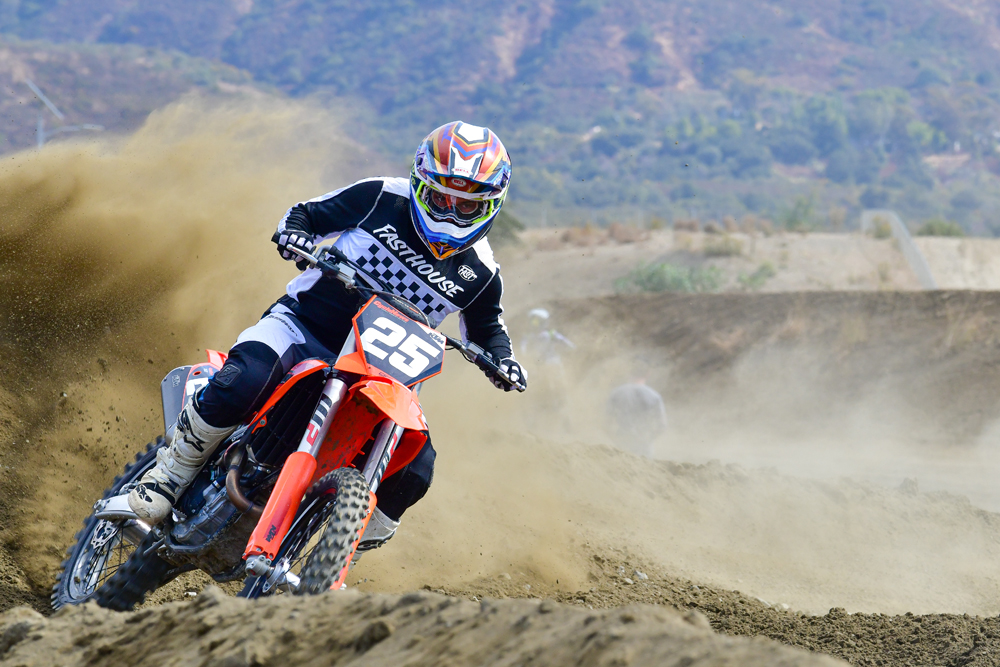
The KTM 250 SX-F crosses the line in a close second place. It might not win the whole thing, but it does take the cake as the best Austrian bike in our test. At just one pound heavier than the Husqvarna, you pay $100 less for regular-sized WP Xact suspension, along with the same electronics and high-quality Brembo brakes. This bumped it past the Husky and rightfully clear of the GasGas.
The KTM is arguably the easiest bike to ride all-around—fast or slow, on smooth or rough ground. This is a bike we could ride all day long in any condition. Initial power is smooth, and the engine is directly connected to your right hand. It blends the best qualities of the high-revving GasGas with the ultra-smooth Husqvarna into a versatile package for any condition. The Austrian bikes are screamers, and the KTM is no different. You can rev this bike into near oblivion, and it just keeps going. The green map has become everyone’s preferred setting, as the more aggressive choice fits the bill for the faster straights and big jumps at Fox Raceway. Torque is plentiful, and the midrange power remains smooth and usable. The traction control and quickshifter are nice options to have, whether you choose to engage them or not. Plain and simple, this motor is the perfect blend of fast and fun for novices and pros.
The KTM’s suspension remains the hottest point of contention. The air fork improves with each iteration, and the lack of springs allows for a weight reduction compared to heavier metal alternatives. Front wheel contact is surprisingly good, providing a consistently trusted feel on the front tire while riding in hard-pack conditions. Bigger jumps or harsh landings are handled with ease as the WP valving ramps up to eliminate harsh slap-down feelings. Additionally, the finger adjusters on the fork and shock are no-brainers when you want to make clicker changes.

The only downfall of the fork is having to monitor its air pressure. We’ve said it time and time again, but you must stay on top of this. Leaving it out in the sun or not checking it for a ride or two can drastically change the feel of this bike. Think of it like checking tire pressure—do it every time you ride, and you’ll enjoy the feel of the KTM.
The new frame feels much more comfortable than previous models. This chassis performs excellently on hard pack and turns easily on flat corners. You can change lines with little to no effort, which enhances the sensation of a nimble machine. Wider footpegs and a neutral cockpit earned further points for the KTM.
The 250 SX-F consistently scored well, never outside of the top three. It is one of the easiest bikes to ride, but as the second most expensive bike in the class, we couldn’t rank it first. Once again, it takes the bridesmaid position to its blue Kryptonite.
1st Place
2025 Yamaha YZ250F

It’s good to be blue. Another year and another win for the Yamaha YZ250F. Last year, this bike entered an all-new generation and still managed to steal the win. Now, after addressing a handful of complaints, it would be nearly impossible for the YZF to lose its spot on top.
For 2025, Yamaha improved their mapping, which is always available for further tuning via the Power Tuner smartphone app. The “Response” map was the go-to for our test. It reduced any initial lag and bolstered the low-end and midrange torque. Now it revs faster and has a fiery snap at the first crack of the throttle. There is no doubt this is a race bike, and it wants to stretch its legs. The YZ comes alive in the mid- and top-end part of the rpm as it revs well past what you think is acceptable. Quiet your senses because your ears will tell you it’s time to shift while the engine continues to climb. It just keeps pulling. The engine is fast and loud, just how it should be.
Yamaha’s KYB suspension is the best in class. The initial comfort is unmatched, and it only gets better the harder you ride it. Going long or coming up short is not a worry. Front-end trust and rear-end compliance become second nature. An updated rear linkage ratio, a lighter rear spring, and corresponding adjustments to the forks were all aimed at improving ground contact and allowing the bike to drive forward. Finger adjusters on top of the fork caps are another nice touch, although they were hardly needed. This front-to-back setup is well liked by every test rider, even the Austrian die-hards.
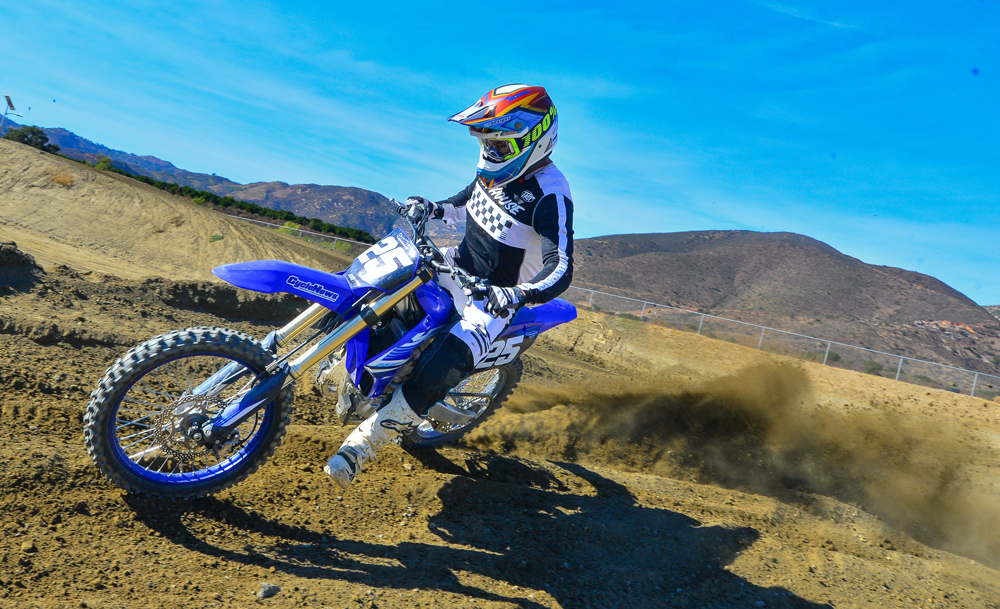
The cockpit on the new-gen Yamaha remains slim and narrow. This design allows riders to move easily from front to back while keeping the bike securely positioned underneath. New footpeg mounts are shaved down for improved grip, reducing the chance of your boots resting on the actual mounts instead of the pegs. Additionally, the throttle tube has been spaced out to alleviate dreaded thumb blisters that can occur from riding a YZ. These small modifications can make a significant difference after an extensive eight-bike test.
What is there to say that hasn’t been said about the new YZF? By far, it feels like the fastest bike of the bunch. Its raw, loud power comes alive quickly and makes you feel like you’re setting the Superpole lap time every time you’re out on the track. However, the front brake and the noise of the airbox continue to leave some room for improvement. We tend to overlook these small flaws as the bike packs a strong engine package and class-leading suspension. Coupled with the easy-to-use Power Tuner app and a sub-10K price, the Yamaha can’t be beat.CN

